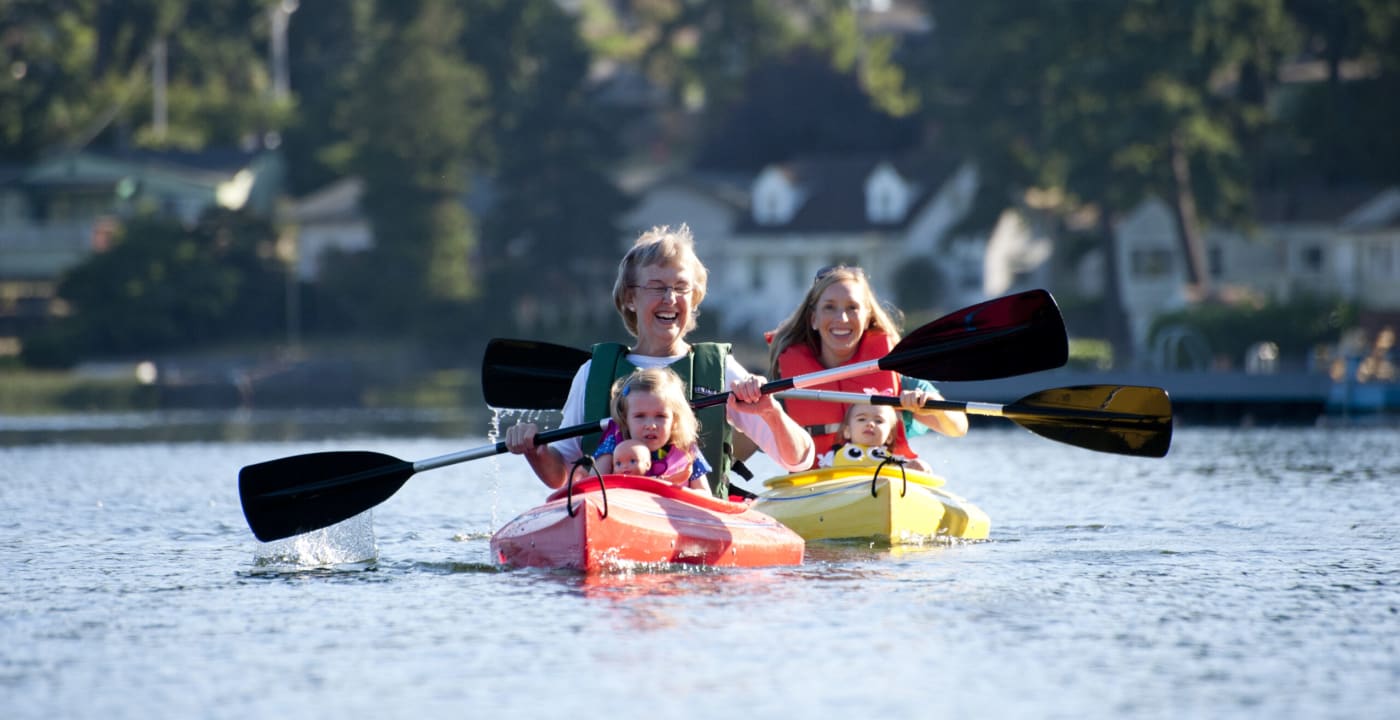Paddle sports and boating safety 101

By Roxanne Cooke
July 20-28 is Paddle Safe Week, a chance to promote safe paddling practices as the popularity of paddlesports grows — and rates of accidents increase.
Since 2012, close to half of all boating fatalities in Washington state involved paddlecraft, according to the U.S. Coast Guard. In 2017, 138 people died while kayaking or canoeing, with the vast majority of those accidents due to drowning.
Follow these tips when kayaking, canoeing or stand-up paddleboarding.
Tips for paddlers
- Take a course to increase your knowledge of paddlesport safety, emergency procedures and navigational rules.
- Pick an activity level that’s suitable for your ability and gear.
- Always wear a life jacket.
- Carry a sounding device (horn, whistle or bell), a navigation light (lantern, flashlight) and visual distress signals such as flares.
- Be visible and wear brightly colored clothing, put reflective tape on paddles, use a flag pole.
- Don’t go out on the water while under the influence of drugs or alcohol.
- Check the weather and know that it can change rapidly.
- Dress for the water temperature, not the air temperature. Expect to get wet.
- Tell your family/friends your specific plan: where you will put in, your planned travel route, exit location and expected return time.
Tips for everyone
Sadly, the risk of drowning while on the water is even higher for children and teens: In Washington, drowning is the second-leading cause of fatal injury for children and teens ages 1 to 17 and number-one cause for ages 1 to 4.
Here are some general water safety tips for anyone planning to paddle, boat, swim or play in the water this summer.
1. Always wear life jackets.
Life jackets may feel like a chore to wear, but they could save your life. According to the U.S. Coast Guard, 85 to 90 percent of boaters who drowned were not wearing life jackets.
You may be thinking “I know how to swim. Why do I need a life jacket?”
But being able to swim won’t necessarily help in chilly Washington waters, which average 50–55 degrees year-round. Water this cold can dangerously lower body temperature, making your limbs numb and swimming difficult.
“You can be an excellent swimmer, but if you can’t move your muscles, you’ll sink like a stone,” says Erin Summa, Health Promotion Coordinator for the Mary Bridge Center for Childhood Safety.
Cold shock response, or the body’s automatic reflex when immersed in cold water, may trigger a deep inhalation of air. If you’re underwater when this happens, you may end up with water in your lungs, making the situation worse.
Life jackets keep you afloat and help your core stay warm.
More water safety tips from Mary Bridge Center for Childhood Safety
Children should always wear a life jacket near open water, whether swimming or boating. Washington state law requires children 12 years old and younger to wear a U.S. Coast Guard-approved life jacket at all times when underway in a vessel less than 19 feet in length.
Even in a “controlled” setting, such as at a swimming pool, or when there’s no plan to get in the water, such as fishing off a dock, Summa advises parents to put life jackets on children.
Be sure to check the fit, too. Fasten all zippers and straps and pull them snug. To test whether it’s fitted properly, pull up on the shoulders. Your child’s ears and chin should not slip through the life jacket.
Water wings, rescue rings and boat cushions are not a replacement for life jackets, and life jackets shouldn’t be a substitute for a designated “water watcher” keeping an active eye on children in the water.
The Mary Bridge Center for Childhood Safety offers free loaner life jackets year-round. Call 253-403-1234 for more information.
2. Enroll your children in swimming lessons.
Swimming doesn’t drown-proof a person, but it’s an important skill to have — and the only sport that could potentially save your life, Summa says.
Enroll your children in swimming lessons every summer to maintain and grow their skills, she suggests.
“It’s not a box you check — it’s ongoing education,” she adds.
The Y of Pierce and Kitsap Counties offers a variety of youth and adult swim lessons at multiple locations. Visit the Y’s website for more information.
Metro Parks Tacoma offers swim lessons as well, plus outdoor and indoor pools open to the public. More information.
3. Obtain a boater safety education card.
Did you know that Washington State law requires operators of power-driven vessels with 15 horsepower or greater — so, basically, all power boats and personal watercraft — to take a safety education course and obtain a Washington state boater education card?
Boaters age 12 and older can take the education course in a classroom, online or at home. You can learn more at the Washington State Recreation and Conservation Office’s boating safety and education website.
4. Remember water hazards exist at home, too.
Water is everywhere, from the toilet to buckets in the backyard. If your child goes missing at home, check sources of water first.
“Toddlers are curious by nature and top-heavy by design,” Summa says.
Never leave your baby or toddler in the tub, even for just a second. Baby bath seats often provide a false sense of security. They are not a safety device, and do not prevent drowning.
If you have a pool at home, be sure to use multiple layers of protection: a four-sided fence, self-closing gate latches, door alarms and spa/pool covers.
Summa also recommends toilet lid locks, since toilets are at perfect reach for a toddler.
More water safety tips from Mary Bridge Center for Childhood Safety
This article was originally published in August 2016 and updated in July 2018.



